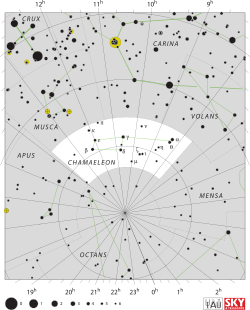Pi Chamaeleontis
| Pi Chamaeleontis (π) | |
 | |
| Observationsdata Epok: J2000.0 | |
|---|---|
| Stjärnbild | Kameleonten |
| Rektascension | 11t 37m 15,63631s[1] |
| Deklination | -75° 53′ 47,5626″[1] |
| Skenbar magnitud () | +5,64[2] |
| Stjärntyp | |
| Spektraltyp | A9 IV[3] eller F1 III[4] |
| U–B | -0,01[5] |
| B–V | +0,35[5] |
| Astrometri | |
| Radialhastighet () | -9,8 ± 3,7[6] km/s |
| Egenrörelse (µ) | RA: -127,94[1] mas/år Dek.: -1,82[1] mas/år |
| Parallax () | 24,09 ± 0,33[1] |
| Avstånd | 135 ± 2 lå (41,5 ± 0,6 pc) |
| Absolut magnitud () | 2,56[7] |
| Detaljer | |
| Massa | 1,52[8] M☉ |
| Radie | 2,2[9] R☉ |
| Luminositet | 8[9] L☉ |
| Temperatur | 6 853 ± 80[6] K |
| Metallicitet | -0,28[6] dex |
| Vinkelhastighet | 50[10] km/s |
| Ålder | 1,8 ± 0,1[7] miljarder år |
| Andra beteckningar | |
| CPD-75° 744, FK5 438, HD 101132, HIP 56675, HR 4479, SAO 256857 | |
Pi Chamaeleontis (π Chamaeleontis, förkortat Pi Cha, π Cha) som är stjärnans Bayerbeteckning, är en ensam stjärna belägen i den norra delen av stjärnbilden Kameleonten. Den har en skenbar magnitud på 5,64[2] och är svagt synlig för blotta ögat där ljusföroreningar ej förekommer. Baserat på parallaxmätning inom Hipparcosuppdraget på ca 24,1[1] mas, beräknas den befinna sig på ett avstånd på ca 135 ljusår (ca 42 parsek) från solen.
Egenskaper
Pi Chamaeleontis är en gul till vit underjättestjärna av spektralklass A9 IV[3] eller F1 III[4]. Den har en massa som är ca 50[8] procent större än solens massa, en radie som är ca 2,2[9] gånger större än solens och utsänder från dess fotosfär ca 8[9] gånger mera energi än solen vid en effektiv temperatur på ca 6 900[6] K.
Källor
- Den här artikeln är helt eller delvis baserad på material från engelskspråkiga Wikipedia, tidigare version.
Referenser
- ^ [a b c d e f] van Leeuwen, F.; et al. (2007). "Validation of the new Hipparcos reduction". Astronomy and Astrophysics. 474 (2): 653–664. arXiv:0708.1752 . Bibcode:2007A&A...474..653V. doi:10.1051/0004-6361:20078357.
- ^ [a b] Allende Prieto, C.; Lambert, D. L. (1999). "Fundamental parameters of nearby stars from the comparison with evolutionary calculations: masses, radii and effective temperatures". Astronomy and Astrophysics. 352: 555–562. arXiv:astro-ph/9911002 . Bibcode:1999A&A...352..555A.
- ^ [a b] Houk, N.; Cowley, A. P. (1975). "University of Michigan Catalogue of two-dimensional spectral types for the HD stars. Volume I. Declinations -90°.0 to -53°.0". Michigan Catalogue of two-dimensional spectral types for the HD stars. 1. Bibcode:1975mcts.book.....H.
- ^ [a b] Kharchenko, N. V.; et al. (2007). "Astrophysical supplements to the ASCC-2.5: Ia. Radial velocities of ~55000 stars and mean radial velocities of 516 Galactic open clusters and associations". Astronomische Nachrichten. 328 (9): 889. arXiv:0705.0878 . Bibcode:2007AN....328..889K. doi:10.1002/asna.200710776.
- ^ [a b] Johnson, H. L. (1966). "UBVRIJKL Photometry of the Bright Stars". Communications of the Lunar and Planetary Laboratory. 4: 99. Bibcode:1966CoLPL...4...99J.
- ^ [a b c d] Casagrande, L.; Schönrich, R.; Asplund, M.; Cassisi, S.; Ramírez, I.; Meléndez, J.; Bensby, T.; Feltzing, S. (2011). "New constraints on the chemical evolution of the solar neighbourhood and Galactic disc(s). Improved astrophysical parameters for the Geneva-Copenhagen Survey". Astronomy & Astrophysics. 530: A138. arXiv:1103.4651 .
- ^ [a b] Holmberg, J.; Nordström, B.; Andersen, J. (2009). "The Geneva-Copenhagen survey of the solar neighbourhood". Astronomy & Astrophysics. 501 (3): 941. arXiv:0811.3982 . Bibcode:2009A&A...501..941H. doi:10.1051/0004-6361/200811191.
- ^ [a b] Lambert, David L.; Reddy, Bacham E. (2004). "Lithium abundances of the local thin disc stars". Monthly Notices of the Royal Astronomical Society. 349 (2): 757. arXiv:astro-ph/0401259 . Bibcode:2004MNRAS.349..757L. doi:10.1111/j.1365-2966.2004.07557.x.
- ^ [a b c d] Chandler, Colin Orion; McDonald, Iain; Kane, Stephen R. (2016). "The Catalog of Earth-Like Exoplanet Survey Targets (CELESTA): A Database of Habitable Zones Around Nearby Stars". The Astronomical Journal. 151 (3): 59. arXiv:1510.05666 . Bibcode:2016AJ....151...59C. doi:10.3847/0004-6256/151/3/59.
- ^ Balachandran, Suchitra (1990). "Lithium depletion and rotation in main-sequence stars". The Astrophysical Journal. 354: 310. Bibcode:1990ApJ...354..310B. doi:10.1086/168691.
Externa länkar
| ||||||||||||||||
Media som används på denna webbplats
Författare/Upphovsman: IAU and Sky & Telescope magazine (Roger Sinnott & Rick Fienberg), Licens: CC BY 3.0
IAU Chamaeleon chart


